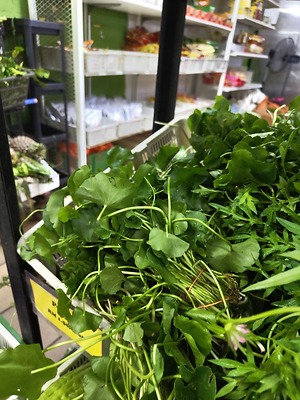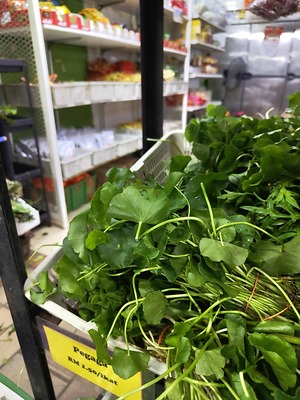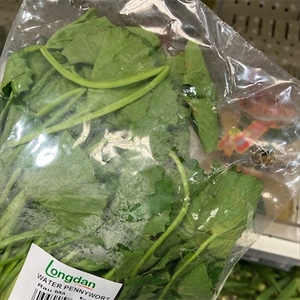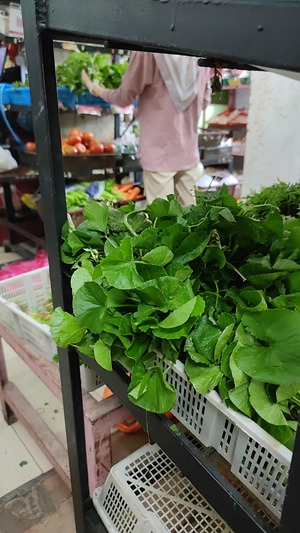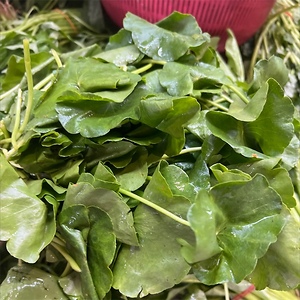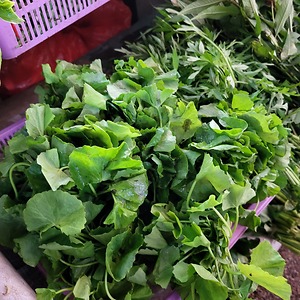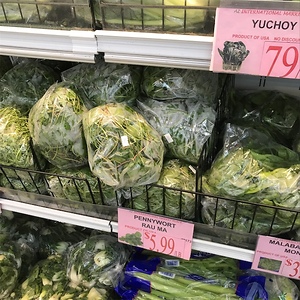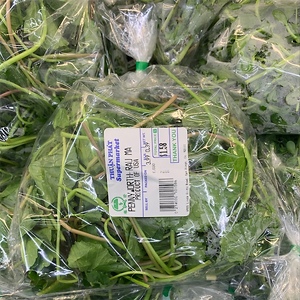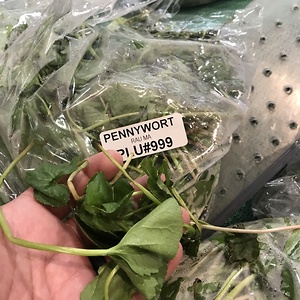

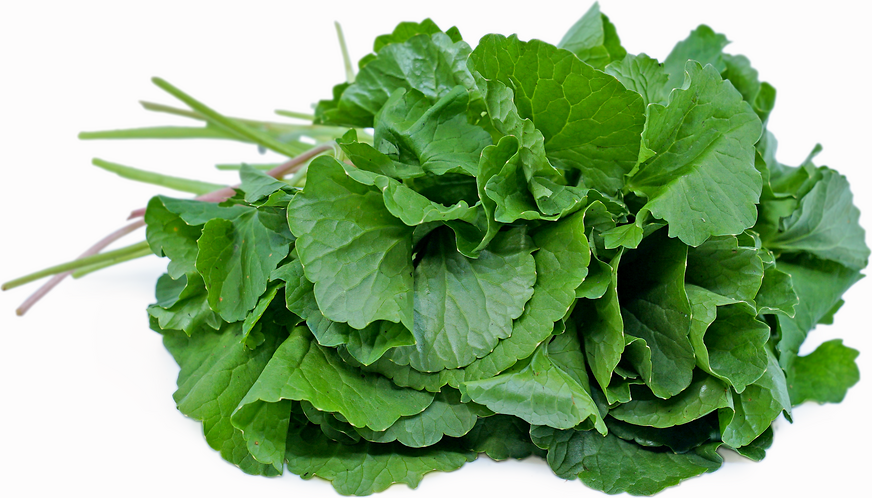
Pennywort
Estimated Inventory, lb : 0
Description/Taste
Pennywort is the name given to a collection of herbs with leafy, round foliage. These plants are low to the ground and tend to spread widely, similar to the growth pattern of clovers. Though there are many varieties of Pennywort, all of them grow on short, thin stems that the entire head of the leaf fits itself around. The way this grass-green herb grows gives it an umbrella-like appearance that’s also compared to an umbilical shape because of how the leaf meets the stem, creating a navel-like appearance. Pennywort leaves measure 5 to 10 centimeters across and have a scalloped edge. Though they have little to no smell, Pennywort possesses a sharp, vegetal taste that can include notes of wheatgrass, watercress, parsley, swiss chard, and cucumber.
Seasons/Availability
Pennywort is available year round in its native regions.
Current Facts
There are many types of Pennywort, all of which fall into the Hydrocotylaceae family despite having different botanical names. Some of the most popular varieties include Asiatic Pennywort, Marsh Pennywort, and Water Pennywort. These varieties are known botanically as Centella asiatica, Hydrocotyle vulgaris, and Hydrocotyle umbellata, respectively. Asiatic Pennywort originates from India, Sri Lanka, and Southeast Asia, while Marsh Pennywort can be found in Europe and North Asia. Water Pennywort grows on the edges of slow-moving streams and ponds in North and South America. Asiatic Pennywort is sometimes called Tiger Grass, reputedly because tigers roll in them when injured. In Sri Lanka, it’s believed that elephants enhance their impressive memory abilities by eating Pennywort.
Nutritional Value
Pennywort contains vitamin B, a nutrient that helps convert carbohydrates, fats, and proteins into energy for your body. It provides vitamin K, which helps with bone metabolism, blood clotting, and maintaining regular calcium levels. This vitamin may also support bone, cognitive, and heart health. Pennywort is a source of calcium, zinc, and magnesium, which may aid in blood sugar management, reduced anxiety, mood regulation, and improved bone health. Throughout time, Pennywort has served numerous medicinal and cosmetic purposes. Asiatic Pennywort has been used topically for healing eczema and open wounds, moisturizing skin, and preventing skin from aging. Fresh Pennywort leaves have been used to treat hepatitis, dysentery, inflammation, and fevers. It's said to help relax blood vessels, strengthen nervous system function, and improve memory, likely contributing to its widespread use in Ayurvedic, Indonesian, and traditional Chinese medicine. Common methods for harnessing the benefits of Pennywort include extracting juice from the leaves and blending them with honey, preparing a decoction with basil and black pepper, turning the leaves into a paste, and crushing or straining them with a sugar mix.
Applications
The stem and flowers of the Pennywort herb are both edible, but the leaves are the most commonly consumed part of the plant. Pennywort leaves are frequently incorporated into juices, smoothies, or teas. In beverages, they have a sharp, distinctly green taste that can be offset when blended with sugar, stevia, lemon, honey, or condensed milk. Pennywort leaves can also be eaten raw, dried, sautéed, or pickled. They can be used as a green in salads or as a parsley-like garnish for dishes. In Burmese cuisine, Asiatic Pennywort is mixed with onions, bean powder, lime juice, fish sauce, and crushed peanuts. There are many different ways to use Pennywort in Sri Lankan cuisine. It’s implemented in a dish called malluma, served alongside rice, dal, jackfruit, and pumpkin curry. It’s also used in a porridge-like dish called kola kenda with rice, coconut milk, and Pennywort purée. Pennywort leaves are complemented by the flavors of ginger, lemongrass, garlic, chilies, tamarind, coriander, and sesame. Foraged Pennywort should be collected from clean water sources and washed thoroughly before eating. The fresh leaves should be used within two days.
Ethnic/Cultural Info
In Chinese culture, Whorled Pennywort represents new beginnings, potential, and endurance. Because its leaves look like coins, Pennywort is also believed to represent prosperity. References to the benefits of Pennywort can be found in the ancient Indian text, the 'Sushruta Samhita,' which dates back over a thousand years. It is said that Tai Chi master Li Ching-Yuen partially attributed his 256-year lifespan to regularly consuming Pennywort supplements. In England, there is a proverb stating, "Two leaves of pennywort a day keeps your old age away,” and in Chinese, Pennywort is known as the “Miracle Elixir of Life.” These epithets reflect the sentiment that Pennywort’s potential to prevent skin from aging, enhance memory, and fend off illness could make people live longer. Floating Pennywort, known botanically as Hydrocotyle ranunculoides, has spread rapidly throughout Britain in the 21st century, causing boat obstacles in waterways and becoming an invasive species that’s caused millions of pounds worth of damage. As of 2016, Floating Pennywort is classified as an Invasive Alien Species of Union concern, forbidding this specific species from being transported, cultivated, planted, or commercialized in the European Union.
Geography/History
The many varieties of Pennywort are native to various regions worldwide, including the US, South and Southeast, Central and South America, South Africa, Eastern Europe, New Zealand, India, Malaysia, and other parts of Eastern Asia. It thrives in tropical, subtropical, and temperate climates and can be found in marshlands, coastlines, wetlands, streams, ditches, canals, lakes, lawns, and ponds. Pennywort is most often found in the wild, though it’s also cultivated in gardens and on farms for its ornamental qualities. Because Pennywort is a creeping plant, its worldwide spread can be largely attributed to the herb's ability to disperse quickly into dense mats throughout various aquatic settings. This characteristic is what caused Floating Pennywort to become an invasive species when it was introduced to the United Kingdom. Pennywort can be foraged from the wild or found in nurseries specializing in aquatic plants.
Recipe Ideas
Recipes that include Pennywort. One
| Indian Kitchen: filled with spices and love |
|
Vallarai Keerai Paruppu Kootu " Brahmi Leaves Curry" |
| Messy Vegetarian Cook |
|
Burmese Pennywort Salad |
| Cooking with Meena |
|
Pennywort Chutney |



